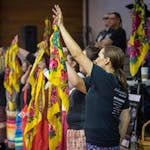As curator of the Hennepin History Museum, Alyssa Thiede spends months meticulously researching, planning and building exhibits for the Minneapolis museum.
But the pandemic changed all of that. The exhibit she was planning to open in fall 2020 had to be canceled. Thiede needed a new idea to fill the space in 2021 — something she could work on safely, finish with a shortened schedule and complete without her normal research channels.
It didn't take long for her to envision the newest exhibit, "Local Heroes," which opened Feb. 4.
"My goal was for it to act as a tribute to health care workers and the sacrifices they make," Thiede said.
But instead of focusing on recent heroes, Thiede traveled back in time. The exhibit chronicles a century of medical innovations and history in the county, beginning with the opening of the first hospital in Hennepin County in 1871.
The exhibit weaves through the next 100 years of medical history, exploring trailblazers, new technologies, important organizations and crucial moments along the way.
The crux of the exhibit is the medical heroes themselves. However, local medical legends typically profiled by historians — Dr. C. Walton Lillehei and Dr. Owen Wangensteen, for example — are not featured. Instead, the focus is on heroes whose stories have been overlooked over the years.
Visitors will learn about people like Josie Wanous Stuart, the first woman to become a licensed pharmacist in the state, and Dr. Ernest Ruiz, an emergency medicine visionary.
The decision to spotlight unsung heroes, many of them women and people of color, was a conscious one, Thiede said.
"I consider that an ongoing mission in any exhibit that I curate," Thiede said. "You want to identify the people that history hasn't focused on previously and make sure that those stories aren't forgotten."
The exhibit also features artifacts from the turn of the 20th century, such as equipment and uniforms. The star artifact is the kidney transporter used during the first kidney transplant in the Midwest in 1963. The operation was performed at Minneapolis General Hospital — now Hennepin County Medical Center.
When she started the project, Thiede had to adjust her research strategy. Visits to local archives and engaging with primary documents was impossible.
"It's not the way I probably would have approached it traditionally," Thiede said. "But it turned out well to have so many individuals that are actual health care professionals working on the exhibit with me."
Those health care professionals helped guide her to people who were well-known in the medical community, but not in the world at large.
The change in process also put her in touch with family members of the health care heroes, such as Benjamin Mchie. Mchie is the nephew of Frances McHie Rains, the first Black woman to graduate from the University of Minnesota School of Nursing.
Mchie, the executive director of the nonprofit African American Registry, said it was fantastic to work with Thiede.
"She has her fingers on a button that's going to be more receptive to whatever diversity can come across and cover looking at the history of the county," Mchie said.
Museum Executive Director John Crippen said it was exciting to watch the exhibit's progress, from Thiede's idea last spring to opening day earlier in February.
Thiede, he said, does a good job of blending her knowledge and research with her artistic side to create a display that succeeds both visually and intellectually.
"It's great stories being told and stories of inspiration, which I think people appreciate at this point in time in particular," Crippen said.
"The stories in this exhibit are from previous eras, but you can see a through-line to the health care system that we have today and how it takes care of people."
The Hennepin History Museum, 2303 S. 3rd Av. in Minneapolis, is open Thursday and Friday from 10 a.m. to 3 p.m. and Saturday from 10 a.m. to 5 p.m. Admission is $8 for adults, $5 for students and seniors, and free for museum members.
Peter Warren • 612-673-1713






